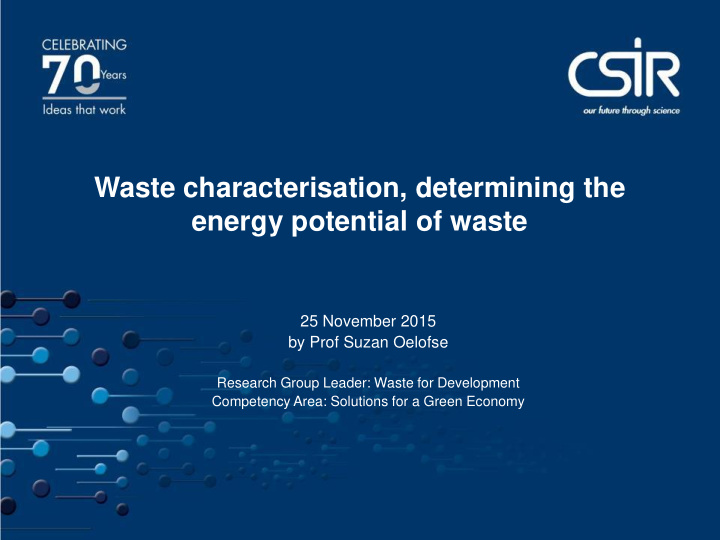



Waste characterisation, determining the energy potential of waste 25 November 2015 by Prof Suzan Oelofse Research Group Leader: Waste for Development Competency Area: Solutions for a Green Economy 1
WtE should consider Fitness for purpose • Feedstock requirements compared to expected feedstock quality • Mass and energy balance • Scale of operation per unit Operational expectations • Reliability of operation assessment (expected availability) • Maintenance requirements 2
Municipal solid waste 3
Why characterisation? • Technologies address discrete segments of the waste stream • Decision support - best management option for different materials/waste streams • “Material flows” modelling • Planning - recycling and composting programmes • Sizing of facilities – WtE based on the residual waste • Estimating costs - transport and separation costs 4
Why local studies? • Provide baseline data to measure progress towards local goals i.e. waste diversion targets • Project material flows in and out of the municipality • Plan for local MSW infrastructure – size and location • Seasonal variability in composition and generation rates • Differences in urban, suburban and rural areas • Extrapolations from other studies could result in costly mistakes – Equipment choices – Sizing of facilities 5
Elements of waste characterisation study • Representative sampling – catering for variability across the City • Four seasons – at least one full week per season • Accurate sorting into multiple waste categories • Waste quantities by generation source • Estimation of the heat value if WtE is considered • Survey of businesses, haulers and brokers to quantify commercial recycling activities and disposal practices 6
Changes in waste over time • Changes in population – Birth rates – Death rates – Migration • Changes in per capita generation – Socio-economic status – Degree of urbanisation – Household size • Recycling, composting and source reduction initiatives 7
Cost of WCS • You get what you pay for – Quick and dirty – Comprehensive • Comprehensive studies are expensive (UNEP, 2015) – Good coverage – Detailed characterisation – Statistical analysis of results • WtE requires multimillion Rand’s worth of investments • High risk associated with poor/uninformed decision making 8
Energy potential of MSW • Depend on the composition of the waste stream • Self-sustained combustibility of the waste • Ash content • Moisture content – Varies by location – Varies by season – Due to rainfall – Causes a directly proportional change in real calorific value 9
WtE Technologies for MSW • Anaerobic digestion Non-burn technologies • Landfill gas recovery • Solid waste incinerators • Gasification • Pyrolysis 10
WtE technologies – Electricity production Technology Electricity production range kWhr/tonne Conventional incineration 500-600 (older) Conventional incineration 750-850 (newer) Gasification 400-800 Plasma Arc Gasification 300-600 Pyrolysis 500-800 11
MSW as energy source • MSW is an inhomogeneous fuel with varying calorific value • Incineration is only viable at lower calorific value above 7MJ/wet kg • Electricity production range of MSW 300 to 850 kWhr/tonne • Electricity production potential range of low grade coal 1 467 to 4 444 kWhr/tonne 12
Conclusions • WtE requires huge capital investments • Decisions on technologies must be based on sound evidence • Technologies are often waste stream specific • Waste characterisation studies provide evidence • Comprehensive studies are costly • Spending money upfront will save money in long run • Calorific value of MSW is low compared to coal • WtE is a by-product of integrated waste management not the driver 13
Thank You Prof Suzan Oelofse E-mail: soelofse@csir.co.za www.csir.co.za 14
Recommend
More recommend